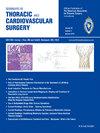Systematic Review of Sublobar Resection for Treatment of High-Risk Patients with Stage I Non-Small Cell Lung Cancer
IF 2.5
3区 医学
Q2 CARDIAC & CARDIOVASCULAR SYSTEMS
Seminars in Thoracic and Cardiovascular Surgery
Pub Date : 2025-03-01
DOI:10.1053/j.semtcvs.2024.11.002
引用次数: 0
Abstract
Sublobar resection offers a parenchymal-sparing surgical alternative to lobectomy and includes wedge resection and segmentectomy. Sublobar resection has been historically utilized in high-risk patients with compromised lung function; however, the technique is becoming more prevalent for normal-risk patients with peripheral stage IA non-small cell lung cancer (NSCLC) <2 cm. In this article, we summarize the technique of sublobar resection, the importance of surgical margins and lymph node sampling, patient selection, perioperative complications, outcomes, and the impact of sublobar resection on the quality of life. There is limited data on short-term and long-term outcomes after sublobar resection for stage I NSCLC in high-risk patients. Results from randomized clinical trials (RCTs) of sublobar resection have been variable. We have summarized the results of the ACOSOG Z4032 RCT, which compared outcomes in high-risk patients who underwent sublobar resection alone versus sublobar resection with brachytherapy for stage I NSCLC. In addition, we have summarized recent findings of the CALGB/Alliance 140503 RCT comparing sublobar resection and lobectomy, which suggested that disease-free survival after sublobar resection in patients with small (<2 cm) peripheral stage IA NSCLC was non-inferior to lobectomy, and another RCT (JCOG 0802) of segmentectomy vs. lobectomy for small peripheral clinical stage IA NSCLC, where segmentectomy was associated with better overall survival despite a higher local recurrence rate. Sublobar resection is primarily performed with minimally invasive approaches, including robotic-assisted and video-assisted thoracoscopic techniques. From an oncologic perspective, obtaining adequate surgical margins and performing an adequate lymph node evaluation are critical for good outcomes after sublobar resection.
叶下切除术治疗高危I期非小细胞肺癌的系统评价。
叶下切除术提供了一种保留肺叶实质的替代手术,包括楔形切除术和节段切除术。叶下切除术历来用于肺功能受损的高危患者;然而,对于周围性肺肿瘤< 2 cm的正常风险患者,该技术正变得越来越普遍。在本文中,我们总结了叶下切除术的技术,手术边缘和淋巴结取样的重要性,患者选择,围手术期并发症,结果,以及叶下切除术对生活质量的影响。对于高风险的I期NSCLC患者进行叶下切除术后的短期和长期预后数据有限。叶下切除术的随机临床试验(rct)的结果是可变的。我们总结了ACOSOG Z4032随机对照试验的结果,该试验比较了高风险I期NSCLC患者单独行叶下切除术与近距离治疗的结果。此外,我们总结了CALGB/Alliance 140503 RCT比较叶下切除术和肺叶切除术的最新发现,该结果表明,小(< 2 cm)外周NSCLC患者叶下切除术后的无病生存率不低于肺叶切除术,另一项RCT (JCOG 0802)对小外周临床期IA期NSCLC进行节段切除术与肺叶切除术后的无病生存率,尽管局部复发率较高,但节段切除术与更好的总生存率相关。叶下切除术主要通过微创方法进行,包括机器人辅助和视频辅助胸腔镜技术。从肿瘤学的角度来看,获得足够的手术切缘和进行足够的淋巴结评估对于叶下切除术后的良好结果至关重要。
本文章由计算机程序翻译,如有差异,请以英文原文为准。
求助全文
约1分钟内获得全文
求助全文
来源期刊

Seminars in Thoracic and Cardiovascular Surgery
Medicine-Pulmonary and Respiratory Medicine
CiteScore
5.80
自引率
0.00%
发文量
324
审稿时长
12 days
期刊介绍:
Seminars in Thoracic and Cardiovascular Surgery is devoted to providing a forum for cardiothoracic surgeons to disseminate and discuss important new information and to gain insight into unresolved areas of question in the specialty. Each issue presents readers with a selection of original peer-reviewed articles accompanied by editorial commentary from specialists in the field. In addition, readers are offered valuable invited articles: State of Views editorials and Current Readings highlighting the latest contributions on central or controversial issues. Another prized feature is expert roundtable discussions in which experts debate critical questions for cardiothoracic treatment and care. Seminars is an invitation-only publication that receives original submissions transferred ONLY from its sister publication, The Journal of Thoracic and Cardiovascular Surgery. As we continue to expand the reach of the Journal, we will explore the possibility of accepting unsolicited manuscripts in the future.
 求助内容:
求助内容: 应助结果提醒方式:
应助结果提醒方式:


